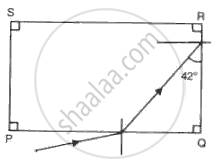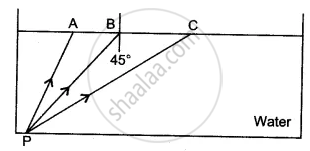Advertisements
Advertisements
प्रश्न
(i) Define critical angle.
(ii) State one important factor which affects the critical angle of a given medium.
उत्तर
(i) The angle of incidence for which the angle of refraction is 90o is called critical angle.
`"_1 mu _2 = (sin i_c)/(sin (90^circ))`
`therefore (mu_2)/(mu_1) = (sini_c)/(1)`
` therefore 1/mu = sini_c " If " mu_2 = 1 mu_1 = mu`
` therefore i_c = sin^(-1) (1/mu)`
(ii) Relative refractive of the medium `("_1 mu_2)`1
APPEARS IN
संबंधित प्रश्न
Write the necessary conditions for the phenomenon of total internal reflection to
occur ?
Solve the previous problem if the paperweight is inverted at its place so that the spherical surface touches the paper.
(a) A ray of monochromatic light enters glass PQRS as shown in the fig. Complete the path of ray till it emerges from the glass. (Critical angle of glass is 420).

(b) Draw diagram of a prism periscope.
(c) What are the advantages of total internal reflecting prism over plane mirror?
If a ray of light passes from medium I to medium II without any change of direction, what can be said about the refractive indices of these media (angle I is not 0)?
How is the critical angle of a material related to its refractive index?
Draw a diagram, properly labelled, to illustrate the use of a total reflecting prism (a right-angled isosceles prism) to turn a ray of light through 180°. Name an instrument in which this device is used.
The diagram shows a point source P inside a water container. Three rays A, B, and C starting from P are shown up to the water surface. Show in the diagram the path of these rays after striking the water surface. The critical angle for the water-air pair is 48°.

Complete the following diagram to show the path of the ray of a single colour in the diagram as if enters in and emerges out of the prism. Mark the angles wherever necessary. (Critical angle for glass = 42°).

Define the critical angle.
State two differences between normal reflection and total internal reflection.
